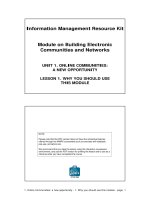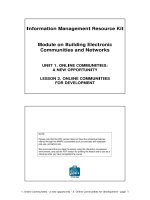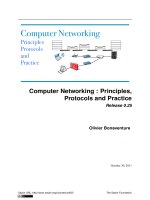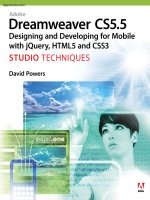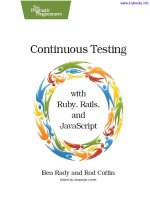UNIT 3. OPTIONS, CHOICES, TOOLS AND APPLICATIONS LESSON 3. ASSESSING TOOLS AND APPLICATIONSNOTE potx
Bạn đang xem bản rút gọn của tài liệu. Xem và tải ngay bản đầy đủ của tài liệu tại đây (1.39 MB, 10 trang )
3. Options, Choices, Tools and Applications - 3. Assessing tools and applications - page 1
Information Management Resource Kit
Module on Building Electronic
Communities and Networks
UNIT 3. OPTIONS, CHOICES, TOOLS AND
APPLICATIONS
LESSON 3. ASSESSING TOOLS
AND APPLICATIONS
© FAO, 2006
NOTE
Please note that this PDF version does not have the interactive features
offered through the IMARK courseware such as exercises with feedback,
pop-ups, animations etc.
We recommend that you take the lesson using the interactive courseware
environment, and use the PDF version for printing the lesson and to use as a
reference after you have completed the course.
3. Options, Choices, Tools and Applications - 3. Assessing tools and applications - page 2
Objectives
At the end of this lesson, you will be able to:
• describe “total cost of use” (TCU)
for the various tools, to the organization
and to community members;
• understand how tools affect online
community building;
• distinguish the specific areas of impact of
tools on the community;
• be aware of the likely impact that different
tools could have on your community.
Introduction
The tools utilized in your community will
affect:
• the total cost of use (TCU) to you and
community members; and
• the nature of the community itself.
In this lesson we will provide a basic
description of TCU of an online
community, both to the organization and
the users.
Furthermore, we will present the specific
areas of impact of tools on the
community.
3. Options, Choices, Tools and Applications - 3. Assessing tools and applications - page 3
Community tools TCU
In general, web based tools are more expensive to implement and have a
higher ongoing cost to community members than e-mail based tools. This is
because of the higher connectivity requirements.
For example, if members are
already equipped and
connected to the Internet,
initial set-up costs will be
minimal; if not they may be
very high.
If members are already
familiar with a particular tool,
training costs will be little or
nothing, while the cost of
learning a sophisticated tool
from scratch may be high.
The relative cost to your organization and to the community members will depend on
the context.
Click on each option, drag it and drop it in the corresponding box.
When you have finished, click on the Check Answer button.
Forum and
Newsgroups
Web sites
TCU to
members
TCU to
organization
For each tool estimate the Total Cost of Use (TCU) to the organization and to the
members of the community.
Medium/High Medium/High
Medium Medium
Low
Low
1)
2)
3)
(A) (B)
(x)
(y) (y)
(z) (z)
(x)
Community tools TCU
3. Options, Choices, Tools and Applications - 3. Assessing tools and applications - page 4
The table looks at
TCU to the
organization
implementing the
online community
project and to
community
members
Community tools TCU
Community tools TCU
Potential costs to the implementing organization/s
Potential costs to community members
Since data mentioned are based on
broad estimates, you will need to
supplement it with specific reflections
on your own community’s context.
In order do this, take a look at some
key factors described in the documents
below.
3. Options, Choices, Tools and Applications - 3. Assessing tools and applications - page 5
Impact of tools on the community
As we said, the tools you adopt will affect
not only the costs to you and community
members, but the nature of the community
itself.
In fact, the tools can help the community to
achieve its objectives, or they can actively
obstruct it.
Both cost and usability factors can affect
the impact of your online community.
For example, tools which are too difficult
to use, or too costly, or which require
too much time to learn to use
effectively, can actively prevent your
community from achieving its objectives.
The case of “The Network for Country School Librarians”
The Network for Country School Librarians was set up to promote
the exchange of information between librarians supporting
schools in rural areas.
The project set up a web based discussion forum for community
members, using the latest web forum software.
Unfortunately, because most of the community members used
older computers and had only dial-up Internet access, they found
it slow and costly to access the forums. Few members
participated actively in discussions, and after a year the network
fizzled out.
Impact of tools on the community
3. Options, Choices, Tools and Applications - 3. Assessing tools and applications - page 6
Examples of unsuitable tools for users with connectivity problems
• Web sites that use too many graphics (photos, illustrations,
decoration) and as a result take a long time to load. While
some graphics are useful they should be kept to a minimum
and “optimised” so as to reduce their size as much as
possible.
• Web sites using unnecessary animations. These will slow
down page loading and cause users extra costs. Animations
can also require users to download extra software in order
to use the web site properly (e.g. plugins or updated
browsers).
• A public unmoderated mailing list that is overloaded with
spam or becomes dominated by postings that are not
relevant to the community. This causes mailbox overload
and makes it expensive to download messages.
• A mailing list that accepts large attachments. These are
expensive for participants to download and may even be
unusable if they depend on unavailable applications.
Impact of tools on the community
Impact of tools on the community
• Participation
• Learning and knowledge sharing
• Social and professional interaction
• Decision making
Let’s see each of them in detail…
These are based on the following specific areas of impact:
Although we cannot identify all factors relating to impact, there are some
considerations about the most suitable tools you can take into account.
3. Options, Choices, Tools and Applications - 3. Assessing tools and applications - page 7
Areas of impact
Participation
If tools are too difficult or
expensive to use, there will be little
active participation in your online
community.
In theory, online communities are
structured horizontally: everyone
participates on the same level,
regardless of their position in the
community, background or
experience.
In practice, differential levels of
technological access can give
members from “resource rich”
organizations an advantage.
Good tools are those to which all members have good access. It could be enough to
provide only one tool (such as e-mail) to which all members have good access, or a
variety of tools for accessing the community (for example, access to discussions via
both e-mail and the Web).
Areas of impact
Learning and knowledge sharing
In a community, members find other people, other visions, and
all sorts of unexpected treasures: they learn the route, acquire
the skills necessary to belong, learn new rules for interacting
with others, learn to master mysterious new machines.
Using appropriate tools is a key part of strengthening this
learning process.
Appropriate tools in this area are those which support archiving of messages
and other content, which make it easy for community members to locate
resources, and which are accessible to all community members.
For example, in a community that uses a mailing list without an archive, it will be harder for participants to
learn effectively.
They may join the community later on and cannot read through previous postings to get a feel for how the
community works.
Other members of the community may want to refer back to older postings that contained useful information or
references, and will not be able to unless they keep their own records.
3. Options, Choices, Tools and Applications - 3. Assessing tools and applications - page 8
Areas of impact
Social and professional interaction
Online communities are gathering
places for people, and people are
bound to develop social and
professional relationships outside the
primary purpose of your project.
Since technology has provided them
with the opportunity for gathering, it is
only natural to expect that they will
regard it also as a valuable tool for
socializing.
In some contexts your initiative might
have been the main reason for putting
people in touch with the technology.
But they are likely to want to continue
using it for other purposes.
Some good tools in this area are: a directory of members included on your
community’s Web site and personal information spaces, such as blogs, that
members can make available to the rest of the community.
Areas of impact
Decision making
Some online communities -
for example, online working
groups and advisory bodies -
may need to make decisions
together online.
In this case the most indicated tools are the synchronous ones, such as chat
rooms or instant messengers. To be more
effective these
tools should include
an archiving facility, so that decisions can be recorded and decision-making
processes tracked.
3. Options, Choices, Tools and Applications - 3. Assessing tools and applications - page 9
Areas of impact
Click on each option, drag it and drop it in the corresponding box.
When you have finished, click on the Check Answer button.
Learning and knowledge
sharing
Social and professional
interaction
Participation
Tools to which all members have
good access
Tools which make it easy for
community members to locate
resources
Personal information spaces, that
members can make available to
the rest of the community
Try to match each area of impact with the corresponding tools.
Decision making
Synchronous tools such as chat
rooms or instant messengers
A
1
Predicting the impact of tools
This table offers some
general information
about the likely
impact of particular
tools on your
community.
3. Options, Choices, Tools and Applications - 3. Assessing tools and applications - page 10
Summary
• The tools used affect not only the cost of setting up and maintaining a community,
but help to shape the nature of the community itself.
• Web based tools are more expensive to implement and have a higher ongoing cost
to community members than e-mail based tools.
• For the TCU of the tools you can count only on generic estimates, which need
to be supplemented with reflections on your own community context.
• You can distinguish four specific areas of impact of tools on the community:
Participation, Learning and knowledge sharing, Social and professional interaction,
Decision making.
If you want to learn more…
Online resources
Marc Osten. What is the Total Value of Technology?
/>Taking TCO to the Classroom: Tools to Estimate the Total Cost of Technology
/>Christian Talbot, D.R, Newman (1998), Beyond Access and Awareness, Evaluating Electronic
Community Networks. />


